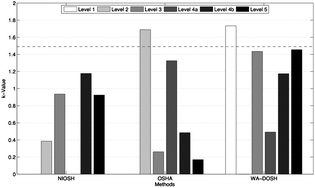A laboratory comparison of analytical methods used for isocyanates†
Abstract
Monomeric and oligomeric 1,6-hexamethylene diisocyanate (HDI) and

Maintenance work is planned for Wednesday 1st May 2024 from 9:00am to 11:00am (BST).
During this time, the performance of our website may be affected - searches may run slowly and some pages may be temporarily unavailable. If this happens, please try refreshing your web browser or try waiting two to three minutes before trying again.
We apologise for any inconvenience this might cause and thank you for your patience.
* Corresponding authors
a
Department of Environmental and Occupational Health Sciences, University of Washington, Box 357234, Seattle, Washington, USA
E-mail:
airion@uw.edu
Fax: +206 616 0477
Tel: +206 685 7243
b Safety & Health Assessment and Research for Prevention (SHARP) Program, Washington State Department of Labor and Industries, Olympia, Washington, USA
c Local Hazardous Waste Management Program, Public Health - Seattle & King County, WA
d Work Environment Department, School of Health and Environment, University of Massachusetts Lowell, Lowell, Massachusetts, USA
e Department of Environmental Sciences and Engineering, Gillings School of Global Public Health, University of North Carolina at Chapel Hill, Chapel Hill, North Carolina, USA
f Washington State Department of Labor and Industries, Olympia, Washington, USA
Monomeric and oligomeric 1,6-hexamethylene diisocyanate (HDI) and

 Please wait while we load your content...
Something went wrong. Try again?
Please wait while we load your content...
Something went wrong. Try again?
D. M. Ceballos, S. G. Whittaker, M. G. Yost, R. L. Dills, D. Bello, J. M. Thomasen, L. A. Nylander-French, C. K. Reeb-Whitaker, P. M. Peters, E. C. Weiland and W. W. Suydam, Anal. Methods, 2011, 3, 2478 DOI: 10.1039/C1AY05225J
To request permission to reproduce material from this article, please go to the Copyright Clearance Center request page.
If you are an author contributing to an RSC publication, you do not need to request permission provided correct acknowledgement is given.
If you are the author of this article, you do not need to request permission to reproduce figures and diagrams provided correct acknowledgement is given. If you want to reproduce the whole article in a third-party publication (excluding your thesis/dissertation for which permission is not required) please go to the Copyright Clearance Center request page.
Read more about how to correctly acknowledge RSC content.
 Fetching data from CrossRef.
Fetching data from CrossRef.
This may take some time to load.
Loading related content
